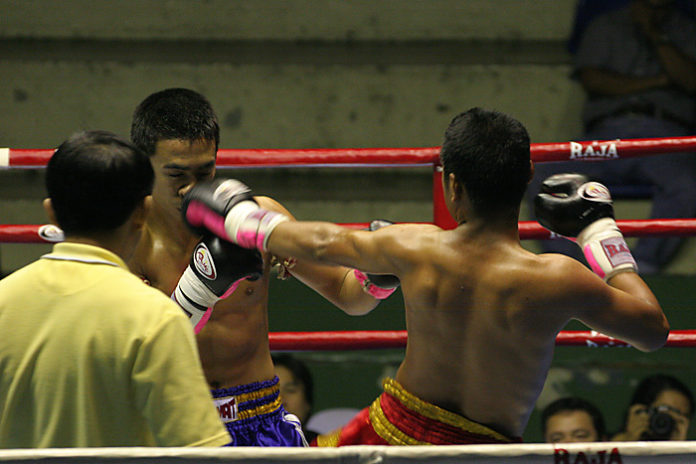Who would win in a Muay Thai vs BJJ fight?
Muay Thai and BJJ are both incredibly popular and effective martial arts. The skills from both arts make up a fundamental component of any unarmed combat system. We’ve broken down each art to compare the strengths and weaknesses of each art relative to the other. We’ll also give our take on who would win in a Muay Thai vs BJJ fight.
Since you’re probably familiar with BJJ, we aren’t going to spend too much time breaking BJJ down. For more information, check out our article ‘What is BJJ, Really?’
What is Muay Thai?
Muay Thai is a striking sport system from Thailand that is like kickboxing. Muay Thai, also known as ‘The Art of Eight Limbs,’ allows a wide range of strikes including kicks, knees, elbows, and punches. Fighters wear 12oz gloves at the professional level. Amateur Muay Thai competitions may have 16oz gloves, shin pads, and head gear depending on the level and promotion.

Unlike boxing and some American Kickboxing rules, Muay Thai allows fighting from a ‘clinch position.’ The clinch allows integration of some sweeps and pummeling techniques. The purpose of the Muay Thai clinch is primarily to set up devastating knee and elbow strikes or drop your opponent with a humiliating sweep and confidently step over their downed body.
How is Muay Thai Scored?
Traditional Muay Thai scoring favors fighters who land kicks, knees, and elbows. The targets for kicks include essentially anywhere on the body except the groin. Leg kicks, body kicks, and head kicks are all within the allowed targets.

Muay Thai is typically three to five rounds of 3 minutes. Like most striking arts, a knockout automatically wins the fight. If no knockout occurs, the fighter who landed more kicks, knees, and elbows, and/or had superior control of the action, typically wins the fight.
Muay Thai vs BJJ: What are the Main Differences?
Rulesets
If you are familiar with typical BJJ rules, you probably already know that the biggest difference is that BJJ does not allow any form of striking. BJJ ‘finishes’ are based on grappling submissions. Points in BJJ rulesets that allow them are based on positional control once the grapplers are on the ground. Takedowns are scored but do not carry the same weight as they would in wrestling.
On the other hand, Muay Thai only allows certain grappling techniques from the clinch. Once a fighter has been dropped, the action stops, the swept fighter stands up, and the striking continues. There are no submissions in Muay Thai. Furthermore, fighters cannot perform any takedowns that involve grabbing the legs with the hands.

The Deeper Difference Between Muay Thai vs BJJ
If we go past the on-paper differences, one of the biggest discerning factors is the goal of each sport. BJJ theoretically involves beating the opponent through superior positioning and submitting them without causing significant damage. Of course, refusing to tap to certain submissions can result in devastating injury, but injury is not the actual goal itself.
Muay Thai, at its core, is about physically hurting the opponent as badly as possible. The highest scored targets for kicks and knees are the head and softer parts of the torso. In other words, the non-groin areas on the body that hurt the worst if you get hit.
A ‘finish’ in Muay Thai is knocking the opponent out. While we all like to joke about ‘getting your bell rung’ or ‘going to sleep’ after a knockout blow, the fact is getting knocked out is no joke. You do not tap out before taking a knockout head kick, knee, or punch. With the growing body of knowledge on the consequences of getting hit in the head, its safe to say Muay Thai is not a friendly sport.
Of course, if you are training safely and do not plan to compete, you can do Muay Thai without expecting too much real damage. Head trauma is an accepted consequence of being a competitive Muay Thai fighter.
In a nutshell, BJJ is about dominating and beating your opponent through control without intentionally causing permanent damage. Muay Thai is about dominating your opponent with kinetic impact to vital organs and the associated pain and delirium.
Who Would Win in a Muay Thai vs BJJ Fight?
Now we will get to the question you probably came here for: who would win in a Muay Thai vs BJJ fight?
This question is unfortunately not straightforward. To give you a semi-complete answer, we will run through a couple of scenarios.
If we assume a BJJ competitor who primarily focuses on BJJ, does not have wrestling experience and does not train striking vs an amateur or higher level Muay Thai competitor, the Muay Thai fighter would likely win the encounter.
The main reason for this is that the BJJ artist would have to clinch to have any shot at implementing BJJ technique. If the BJJ player does not have good wrestling, the Muay Thai fighter would likely devastate the BJJ guy with knees and elbows in any tie-up. That is also assuming the BJJ guy could even close the distance.
On the other hand, the typical Muay Thai group class attendee who is not a competitor at all may not have enough experience against resisting opponents to implement the striking techniques. It is quite common for people to train Muay Thai but strictly attend non-sparring pad work or drilling based classes. In BJJ, you are pretty much going live regardless of how serious of an athlete you are. As such, if you are an average BJJ guy facing the typical group striking class attendee, you probably have a good shot at winning the fight.

Once we start comparing BJJ players with wrestling experience versus various levels of Muay Thai fighter, we are basically talking about MMA. When it comes to MMA fighting, there are many factors at play, and it becomes iffy to compare the arts on their own.
At the end of the day, competitive Muay Thai has a distinct advantage against a pure BJJ stylist without much standup experience.
Muay Thai vs BJJ for Self-Defense
If you do not plan to go around doing style-vs-style fights, you may still be wondering which art is superior for self-defense.
This question becomes even more complicated.
Personally, we feel that overall, BJJ is a better art for self-defense. We have a few major reasons for this sentiment.

Real BJJ is More Accessible to Average People
The biggest factor of making any martial art ‘work’ in a live scenario is the ability to impose the techniques on a fully resisting opponent.
Regardless of who you are in BJJ, you are 99.99% of the time going to train against 100% resistance within your first year of training. It would be almost unheard of to say ‘yeah I’ve been doing BJJ for over a year and have never rolled live.’
On the other hand, most people who attend your typical ‘Muay Thai’ class may never really spar against anyone with enough intensity to learn how to apply techniques against fully resisting opponents.
One of the main reasons for this is the head damage and pain associated with Muay Thai.
The greatest thing about BJJ is that you can train very safely with high levels of intensity. This is simply not the case with Muay Thai. In fact, unless you are a competitive Muay Thai fighter, there is a good chance you’ll never spar with full intensity. Certainly not frequently enough to reliably impose striking against an attacker.
You can absolutely train Muay Thai and become effective with the techniques. You just need to understand that you will have to spar with intensity on a semi-regular basis.
BJJ Allows a Greater Range of Force Against an Attacker
One of the greatest things about BJJ is that it allows a range of force to be applied against the opponent. Assuming you have sufficient BJJ skill, you could theoretically subdue and control a fully resisting opponent without the need to do any real damage. Heck, you can choke someone unconscious without risking permanent damage (assuming you promptly revive them).
Of course, in the real world of violence, you may not have the luxury of controlling the outcome of a fight as perfectly as BJJ theoretically allows. However, with Muay Thai you have no chance at this luxury. A high-level Muay Thai guy could easily ‘beat’ an untrained attacker. However, the level of force available with Muay Thai techniques is essentially 100%.
In many self-defense situations, you may know the attacker. You may need to control a drunken family member, child, or mentally unstable individual. If all you have is potentially lethal knockout blows at your disposal, you are somewhat limited in your ability to control the scenario.
With some decent working knowledge of BJJ, you can control an individual in these scenarios with less risk of immediate deadly-force escalation.
Obviously, in a deadly-force life-and-death scenario, this continuum may not be a factor. However, if that is the case, you might consider using a force multiplier – also known as a weapon.
Muay Thai vs BJJ: Which Art Should I Train?
At the end of the day, the most important factor of training martial arts is your level of enjoyment. Both Muay Thai and BJJ are effective forms of fighting. However, you have to commit to the training to make them effective. If you hate the training, you probably won’t stick with it long enough to be effective.
We are partial to BJJ training of course, however ultimately, only you can decide which art suits you the best when it comes to Muay Thai vs BJJ.
Explore similar topics:
Explore other topics:
- The Best BJJ Strength and Conditioning Program
- Essential No Gi BJJ Gear
- The Best Jiu Jitsu Documentaries





